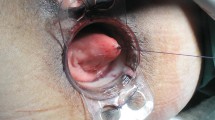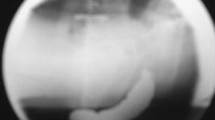Abstract
Purpose
This study was designed to assess the safety and outcomes achieved with stapled transanal rectal resection vs. biofeedback training in obstructed defecation patients.
Methods
A total of 119 women patients who suffered from obstructed defecation with associated rectocele and rectal intussusception were randomized to stapled transanal rectal resection or biofeedback training. Stapled transanal rectal resection was performed by using two circular staplers to produce transanal full-thickness rectal resection. Primary outcome was symptoms of obstructed defecation resolution at 12 months; secondary outcomes included safety, change in quality of life score, and anatomic correction of rectocele and rectal intussusception.
Results
Fourteen percent (8/59) stapled transanal rectal resection and 50 percent (30/60) biofeedback training patients withdrew early. Eight (15 percent) patients treated with stapled transanal rectal resection and 1 (2 percent) biofeedback patient experienced adverse events. One serious adverse event (bleeding) occurred after stapled transanal rectal resection. Scores of obstructed defecation improved significantly in both groups as did quality of life (both P < 0.0001). Successful treatment was observed in 44 (81.5 percent) stapled transanal rectal resection vs. 13 (33.3 percent) evaluable biofeedback training patients (P < 0.0001). Functional benefit was observed early and remained stable during the study.
Conclusions
In this controlled trial, stapled transanal rectal resection was well tolerated, was more effective than biofeedback training for the resolution of obstructed defecation symptoms, and improved quality of life, with minimal risk of impaired continence. Thus, stapled transanal rectal resection offers a new treatment alternative for obstructed defecation after failure of conservative measures including biofeedback training, a noninvasive approach.




Similar content being viewed by others
References
Talley NJ, Weaver AL, Zinsmeister AR, Melton LJ 3rd. Functional constipation and outlet delay: a population-based study. Gastroenterology 1993;105:781–90.
Siproudhis L, Dautreme S, Ropert A, et al. Anismus and biofeedback: who benefits. Eur J Gastroenterol Hepatol 1995;7:547–52.
van Dam JH, Hop WC, Schouten WR. Analysis of patients with poor outcome of rectocele repair. Dis Colon Rectum 2000;43:1556–60.
Mimura T, Roy AJ, Storrie JB, Kamm MA. Treatment of impaired defecation associated with rectocele by behavorial retraining (biofeedback). Dis Colon Rectum 2000;43:1267–72.
Boccasanta P, Venturi M, Calabro G, et al. Which surgical approach for rectocele? A multicentric report from Italian coloproctologists. Tech Coloproctol 2001;5:149–56.
Altomare DF, Rinaldi M, Veglia A, Petrolino M, De Fazio M, Sallustio P. Combined perineal and endorectal repair of rectocele by circular stapler: a novel surgical technique. Dis Colon Rectum 2002;45:1549–52.
Jayne DG, Finan PJ. Stapled transanal rectal resection for obstructed defaecation and evidence-based practice. Br J Surg 2005;92:793–4.
Corman ML, Carriero A, Hager T, et al. Consensus conference on the stapled transanal rectal resection (STARR) for disordered defaecation. Colorectal Dis 2006;8:98–101.
National Institute for Health and Clinical Excellence. Stapled transanal rectal resection for obstructed defaecation syndrome. Available at: http://guidance.nice.org.uk/IPG169/guidance/pdf/English/download.dspx. Accessed March 30, 2008.
Amin AI, Hallbook O, Lee AJ, Sexton R, Moran BJ, Heald RJ. A 5-cm colonic J pouch colo-anal reconstruction following anterior resection for low rectal cancer results in acceptable evacuation and continence in the long term. Colorectal Dis 2003;5:33–7.
Boccasanta P, Venturi M, Stuto A, et al. Stapled transanal rectal resection for outlet obstruction: a prospective, multicenter trial. Dis Colon Rectum 2004;47:1285–97.
Marquis P, De La Loge C, Dubois D, McDermott A, Chassany O. Development and validation of the Patient Assessment of Constipation Quality of Life questionnaire. Scand J Gastroenterol 2005;40:540–51.
Oliveira L, Pfeifer J, Wexner SD. Physiological and clinical outcome of anterior sphincteroplasty. Br J Surg 1996;83:502–5.
Anonymus. World Medical Association Declaration of Helsinki: ethical principles for medical research involving human subjects. JAMA 2000;284:3043–5.
Whitehead WE, Wald A, Diamant NE, Enck P, Pemberton JH, Rao SS. Functional disorders of the anus and rectum. Gut 1999;45(Suppl 2)II55–9.
Thompson WG, Longstreth GF, Drossman DA, Heaton KW, Irvine EJ, Muller-Lissner SA. Functional bowel disorders and functional abdominal pain. Gut 1999;45(Suppl 2)II43–7.
Dodi G, Pietroletti R, Milito G, Binda G, Pescatori M. Bleeding, incontinence, pain and constipation after STARR transanal double stapling rectotomy for obstructed defecation. Tech Coloproctol 2003;7:148–53.
Boccasanta P, Venturi M, Salamina G, Cesana BM, Bernasconi F, Roviaro G. New trends in the surgical treatment of outlet obstruction: clinical and functional results of two novel transanal stapled techniques from a randomised controlled trial. Int J Colorectal Dis 2004;19:359–69.
Arroyo A, Perez-Vicente F, Serrano P, et al. Evaluation of the stapled transanal rectal resection technique with two staplers in the treatment of obstructive defecation syndrome. J Am Coll Surg 2007;204:56–63.
Acknowledgments
The authors thank Aysgarth Statistics, Beaconsfield, United Kingdom, for statistical analysis, and Physicians World GmbH, Mannheim, Germany, for medical writing.
Author information
Authors and Affiliations
Consortia
Corresponding author
Additional information
Supported by grants from Ethicon Endo-Surgery (Europe) GmbH, Norderstedt, Germany.
An erratum to this article can be found at http://dx.doi.org/10.1007/s10350-008-9434-x
About this article
Cite this article
Lehur, P.A., Stuto, A., Fantoli, M. et al. Outcomes of Stapled Transanal Rectal Resection vs. Biofeedback for the Treatment of Outlet Obstruction Associated with Rectal Intussusception and Rectocele: A Multicenter, Randomized, Controlled Trial. Dis Colon Rectum 51, 1611–1618 (2008). https://doi.org/10.1007/s10350-008-9378-1
Received:
Revised:
Accepted:
Published:
Issue Date:
DOI: https://doi.org/10.1007/s10350-008-9378-1




